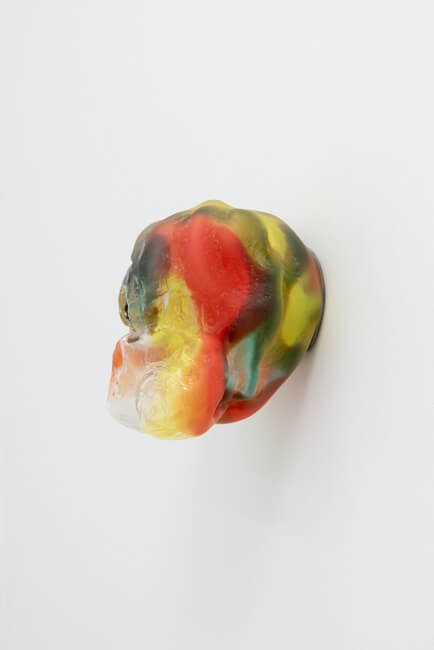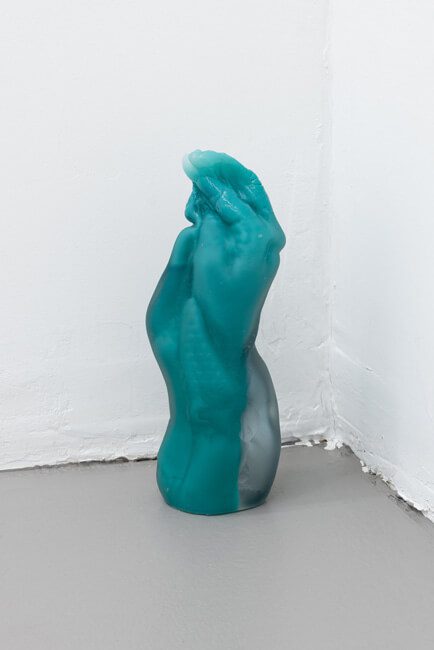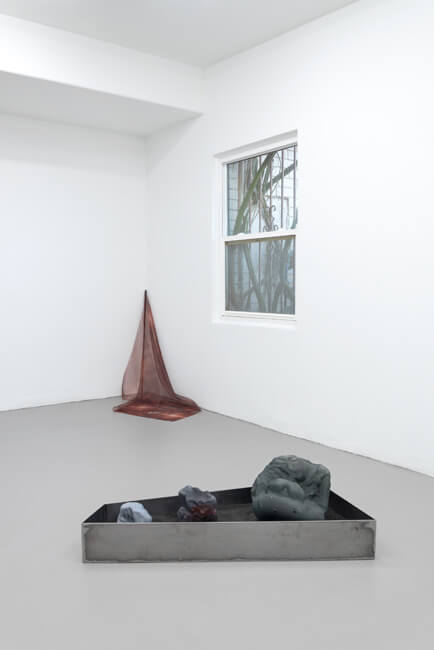Sara Hubbs’s exhibition Soft shoulder at Everybody gallery in Tucson pays homage to the inseparability of art and life.
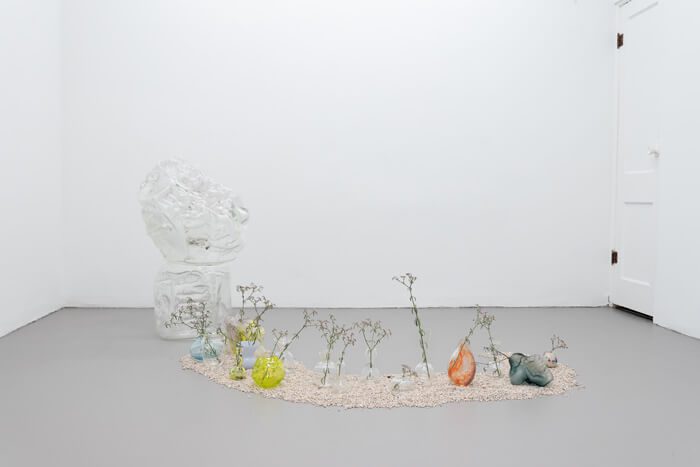
Sara Hubbs: Soft shoulder
February 12–March 26, 2022
Everybody, Tucson
The desire to touch imbues the work with an indelible energy in Sara Hubbs’s exhibition Soft shoulder. In one of the two rooms that make up Everybody gallery in Tucson, Arizona, Hubbs’s Tending the Garden (which was also featured in Southwest Contemporary Vol. 3) takes the center of the space with a curve of small rocks. The mold- and hand-blown glass placed on the rocks all hold a sprig of Baja Spurge—the tiny white flowers clustered on leafless branches had browned by the time I visited. I can imagine the artist adjusting each piece, like a viewer might have arranged and rearranged objects in their home while in isolation. A clear glass form sits at one end of the landscape. The side facing the door looks like a mold taken from enlarged, crumpled foil. The opposite side mimics legs, giving the sculpture a hauntingly human form.
The two additional works in the room, IRL: Peace and Luck and Hand-held, also incorporate human forms—hands in the former and what appears to be an abdomen bent over backward in the latter. With IRL: Peace and Luck, Hubbs uses an opaque cyan which, coupled with the hands, teases the viewer into wanting to touch and hold the smooth surface of the glass until it becomes body temperature.
When I think of glass, I think of fragility. The glass set on top of the layer of rocks and their smooth surfaces against the cut stone contrasts smooth surfaces against rough ones. But a quick search tells me that temperatures of upwards of 2,000 degrees Fahrenheit are needed to melt glass. Temperature ranges I can’t even imagine. The title of the exhibition conjures the image of the bumps of bone where the clavicle connects to the shoulder. It reminds me of how there isn’t much between skin and bone, which makes the area sensitive. It reminds me how hard my shoulders have become from stress.
In the second room of the exhibition, the glass works look solid, are darker in color, and seem increasingly heavy. Rind #2 comprises two glass objects strung up with wall hooks, necklace chain, plastic price tag fasteners, zip ties, and keychains. It presents me with a dilemma: will all the loops break and drop the glass, allowing the glass to burst on the floor? I wonder which substance will last the longest between glass, metal, and plastic. They will all probably remain on this planet longer than my flesh.
In the exhibition essay, Lauren R. O’Connell writes that Hubbs’s work is “conceptually grounded in the transformative qualities of relationships” and informed both by elder and child care. I’m reminded of that with The Hope of Gesture. The color of the printed fabric is reminiscent of menstrual fluid; the ambiguous image makes me think of blood clots. Menstruation is a regular reminder of my mortality, how I was made, and that I have the potential to create. While I cannot relate to Hubbs’s relationships exactly, The Hope of Gesture encapsulates how human life is full of possibility and always ends in death. A piece of rebar holds up the translucent rectangle of fabric. The edges of the fabric aren’t sealed and threads break away. A glass hook is left seemingly thoughtlessly, as if forgotten, and whether it can function without breaking is untested.
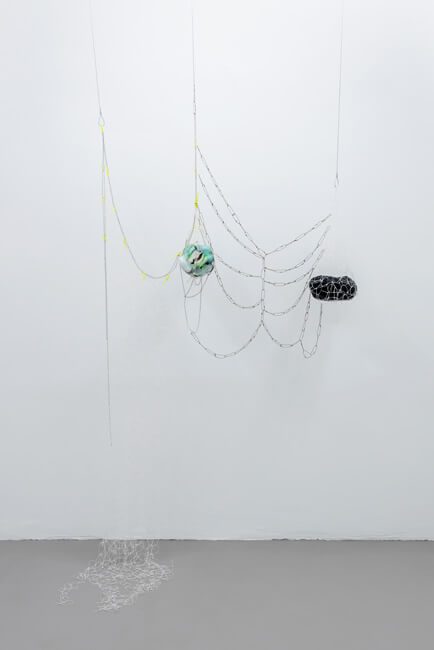
In an old brick fireplace at the back of the gallery, Small Volcanoes anchors the show like a fire that draws everyone closer together at a party. It sits in the space facing out, as if waiting for you to cozy up to it and start a conversation. Of The Horizon is displayed in the center of this room, where black aquarium sand is contained by a steel shape. One error in the weld would allow the sand to spill onto the floor. Three glass sculptures are situated within the framework. I resist the urge to run fingers through the sand or sprinkle a pinch of it on the gallery floor. I expect to find a miniature rake hidden somewhere.
Soft shoulder is filled with exquisitely quiet moments as the sculptures insert their presence and potential movement onto the viewer. The exhibition essay tells me that the plaster cast molds for the sculptures were made from plastic toy packaging. In a world ravaged by a pandemic, this signifier of empty space that is now filled feels heavy. Perhaps that is why I’m so moved to want to touch the sculptures, to hold them close in response to how far away I’ve held everyone for the past two years.
Sara Hubbs: Soft shoulder continues through March 26, 2022, at Everybody, 437 East Grant Road, Tucson.
